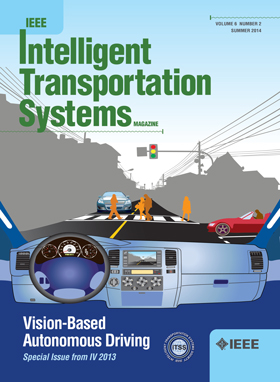An Attention Deep Learning Framework-Based Drowsiness Detection Model for Intelligent Transportation System
IF 7.9
1区 工程技术
Q1 ENGINEERING, CIVIL
IEEE Transactions on Intelligent Transportation Systems
Pub Date : 2025-02-27
DOI:10.1109/TITS.2025.3544138
引用次数: 0
Abstract
Drivers’ drowsiness has been considered one of the prime reasons for accidents and road fatalities. Drowsiness may be caused by sleep disorders resulting in unusual mental and health conditions that have detrimental effects on human lives. This article aims to present an attention deep learning (DL) framework for drivers’ drowsiness monitoring for an intelligent transportation system. The proposed imaging system, comprising an Infrared-Cut camera embedded in a microcomputer, has been employed for capturing both day and night mode images for automated detection of drivers’ drowsiness. The frames captured are preprocessed and fed to the proposed attention DL framework based on “you only look once” version 3 (YOLOv3) for eye region detection followed by eye state classification and interpretation. Feature extraction has been carried out via a convolutional neural network module, and multiscale fusion along with the non-maximum suppression method has been applied to detect and classify the eye region of the drivers for monitoring drowsiness. Moreover, the eye region has been interpreted via a classification activation map using the proposed attention module. Experimental evaluations reveal the efficacy of the proposed system on our acquired dataset and two benchmark datasets. The proposed drowsiness detection device and system can possess good potential by increasing safety in an advanced driver assistance system.基于注意力深度学习框架的智能交通系统困倦检测模型
司机的困倦被认为是交通事故和道路死亡的主要原因之一。困倦可能是由睡眠障碍引起的,导致不寻常的精神和健康状况,对人类生活产生有害影响。本文旨在提出一个用于智能交通系统驾驶员困倦监测的注意力深度学习(DL)框架。所提出的成像系统,包括一个嵌入在微型计算机中的红外切割照相机,已被用于捕获白天和夜间模式图像,以自动检测驾驶员的睡意。对捕获的帧进行预处理,并将其馈送到基于“你只看一次”版本3 (YOLOv3)的注意力深度学习框架中,用于眼睛区域检测,然后进行眼睛状态分类和解释。通过卷积神经网络模块进行特征提取,并应用多尺度融合和非最大抑制方法对驾驶员的眼区进行检测和分类,以监测驾驶员的困倦状态。此外,通过使用所提出的注意模块的分类激活图来解释眼睛区域。实验评估显示了该系统在我们获得的数据集和两个基准数据集上的有效性。所提出的睡意检测装置和系统在高级驾驶辅助系统中具有良好的应用潜力,可以提高安全性。
本文章由计算机程序翻译,如有差异,请以英文原文为准。
求助全文
约1分钟内获得全文
求助全文
来源期刊

IEEE Transactions on Intelligent Transportation Systems
工程技术-工程:电子与电气
CiteScore
14.80
自引率
12.90%
发文量
1872
审稿时长
7.5 months
期刊介绍:
The theoretical, experimental and operational aspects of electrical and electronics engineering and information technologies as applied to Intelligent Transportation Systems (ITS). Intelligent Transportation Systems are defined as those systems utilizing synergistic technologies and systems engineering concepts to develop and improve transportation systems of all kinds. The scope of this interdisciplinary activity includes the promotion, consolidation and coordination of ITS technical activities among IEEE entities, and providing a focus for cooperative activities, both internally and externally.
 求助内容:
求助内容: 应助结果提醒方式:
应助结果提醒方式:


